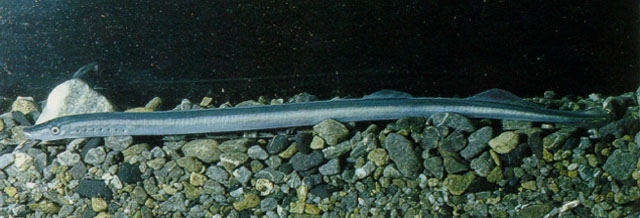| Geotriidae (Southern lampreys) |
| 57 cm TL (male/unsexed) |
|
demersal; freshwater; brackish; marine, anadromous |
| South Pacific: South Australia, South New Zealand, Chile. South Atlantic: Argentina, Falkland and South Georgia islands. |
|
Adult: 7.6-57.0 cm TL; body proportions, as percentage of TL (based on 17 specimens measuring 9.0-57.0 cm TL): 8.3-20.2 prebranchial length, 7.9-11.8 branchial length, 47.6-61.5 trunk length, and 16.1-31.1 tail length; urogenital papilla not prominent in mature adults; trunk myomeres, 70-78; dentition: supraoral lamina with 4 unicuspid teeth (2 pointed central ones flanked by broad lateral flanges), infraoral lamina with 9-15 unicuspid teeth, 8-9 unicuspid endolaterals on each side, 5-7 rows of anterials, first row of anterials with 1-4 unicuspid teeth, 6-8 rows of exolaterals on each side, 1 row of posterials in feeding phase adults with 12 radial plates possibly flanked on each side by 2 unicuspid teeth and in spawning adults about 3 rows (the first consisting of 9 unicuspid teeth), transverse lingual lamina with 3 unicuspid teeth (the median one enlarged in recently metamorphosed individuals), 3 unicuspid teeth (the lateral ones greatly enlarged in feeding individuals and 2 unicuspid teeth in mature individuals), longitudinal lingual laminae each with 4 unicuspid teeth; velar tentacles, 23-40; body coloration (live) in prespawning adults: dorsal surface dark with a pair of longitudinal blue-green stripes running along the dorso-lateral aspect and ventral surface silvery; spawning adults dark blue on dorsal surface and light blue on ventral surface; lateral line neuromasts darkly pigmented; caudal fin shape, rounded; oral fimbriae, 55-65; oral papillae, 16-19 (Ref. 89241). |
| Found in mud burrows in upper reaches of coastal streams for the first four years of life until metamorphosis and subsequent downstream migration to the sea (Ref. 44894). Adults inhabit the sea for an undetermined period and are parasitic on other fishes. Migrate upstream which may last for 16 months and spawn in freshwater (Ref. 5154). Adults are often found below weirs and dams during their spawning migration which may take them 60 km or more upstream of the coast (Ref. 44894). Migration mostly takes place in rainy nights when water levels are rising, with temperatures between 12-14.5°C and when there is extensive cloud cover or during the dark phase of the moon (Ref. 5154). Stones with a volume of 144 ml, equivalent in size to a tennis ball, can be transported by adults using their oral disc (Ref. 89241). Sometimes they exit the water by wriggling up the bank to bypass obstacles to migration (Ref. 44894). Adults stop feeding while in freshwater and die shortly after spawning. Maximum length reported to reach 62 cm TL (Ref. 5154). Common length is 45-50 cm SL. Status of abundance decreased due to proliferation of obstacles such as dams and weirs to upstream spawning runs (Ref. 44894). Fecundity, 48,004 to 68,212 eggs/female (Ref. 89241).
In New Zealand, the Maori use the pouched lamprey at the beginning of their upstream migration for human consumption and ceremonial purposes (McDowall, 1990). These are caught using weirs built along river edges or collected by hand as they are making their way up the rocky face of falls. They are then dried for human consumption (Ref. 89241). |
|
Data deficient (DD); Date assessed: 23 February 2021 Ref. (130435)
|
| harmless |
Source and more info: www.fishbase.org. For personal, classroom, and other internal use only. Not for publication.

